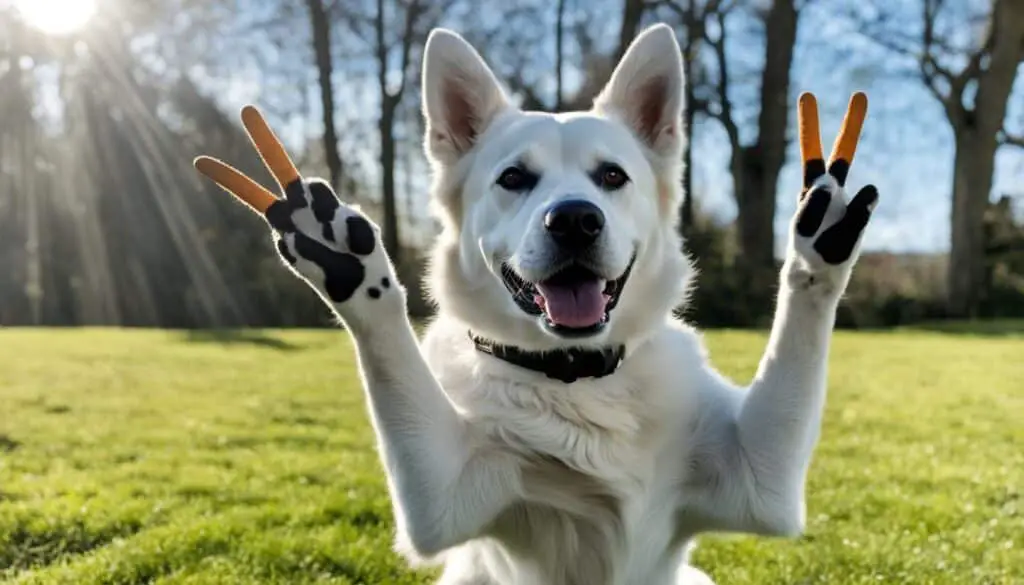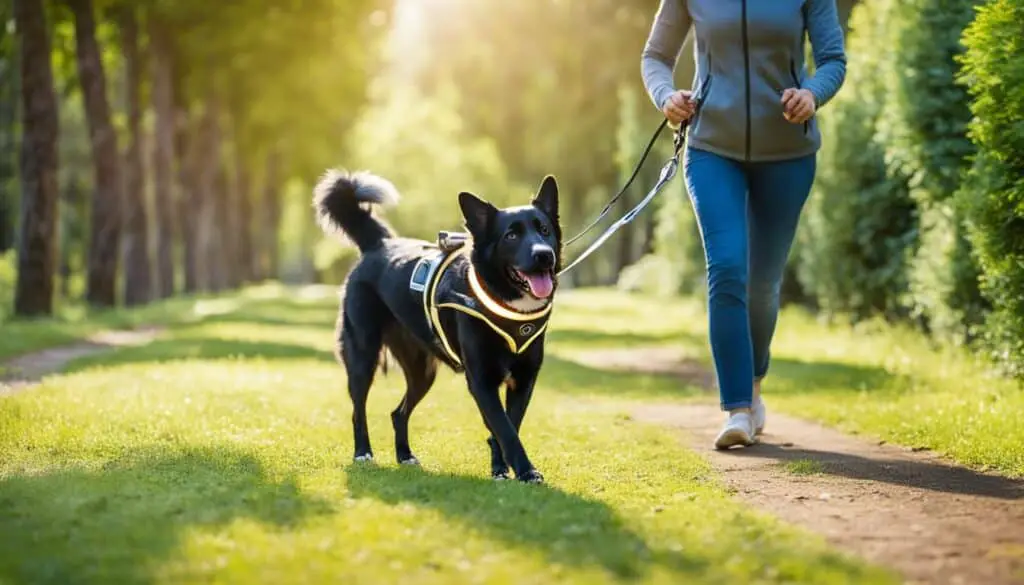As a pet lover, I understand the unique needs of our furry friends, especially when they have disabilities. It’s important to remember that pets with disabilities can still live fulfilling lives, and with the right training techniques, we can help them thrive. Whether it’s a small dog, a cat, or any other pet, adaptive training methods can be tailored to suit their individual needs, ensuring that they receive the care, attention, and love they deserve.
Training small pets with disabilities requires an understanding of their specific challenges and finding creative ways to communicate and bond with them. In this article, I’ll share some adaptive training techniques that can help you establish a deeper connection with your pet and promote their overall wellbeing. Let’s explore the different types of disabilities in pets and how we can adapt our training approaches to cater to their unique requirements.
Key Takeaways
- Training small pets with disabilities requires adaptive techniques.
- Pets with disabilities have unique needs that must be addressed in their training.
- Bonding with your disabled pet is crucial for their wellbeing.
- Adaptive training promotes effective communication with pets with disabilities.
- Training disabled pets can be a rewarding and fulfilling experience.
Types of Disabilities in Pets
When it comes to our beloved pets, they can face a variety of disabilities that may impact their daily lives. These disabilities can stem from congenital diseases, contracted diseases, or injuries. It is essential for pet owners to understand the different types of disabilities that their furry friends may encounter, allowing them to provide appropriate care and support.
Some of the most common disabilities in dogs include:
- Blindness: Blindness in dogs can be caused by congenital diseases, eye infections, or injuries. It can significantly affect their mobility and overall quality of life.
- Deafness: Deafness can occur in dogs over time due to chronic ear infections or developmental issues. This disability impacts their ability to respond to auditory cues and communicate effectively.
- Mobility challenges: Dogs can face mobility challenges due to spinal cord injuries, certain diseases, or limb amputations. These challenges can severely limit their ability to move and perform daily activities.
Understanding the specific disability that your pet may have is crucial in providing them with the right care, as each disability requires unique approaches and accommodations. To further explore the various disabilities in pets and their corresponding adaptations, refer to the table below:
| Disability | Cause | Adaptive Techniques |
|---|---|---|
| Blindness | Congenital diseases, eye infections, injuries | Scent mapping, physical contact, hand signals, halos |
| Deafness | Chronic ear infections, developmental issues | Clicker training, visual cues, vibrating collars |
| Mobility challenges | Spinal cord injuries, diseases, limb amputations | Physical therapy, mobility aids, assistive devices |
It is important to note that while some disabilities may be present from birth (congenital), others may be acquired through diseases or injuries. Each disability requires specific adaptive techniques and modifications to ensure the well-being and happiness of our furry companions.
Adaptation Based on Senses
Dogs possess heightened senses, making them incredibly perceptive beings. Their acute sense of smell and hearing allows them to navigate and interact with the world in unique ways. To effectively train and communicate with disabled dogs, it is essential to understand and adapt to their heightened senses.
Sense of Smell:
A dog’s sense of smell is far more powerful than that of humans. They have up to 300 million olfactory receptors, compared to the 6 million found in humans. This heightened sense of smell enables dogs to detect scents at incredibly low levels, making them excellent trackers and search-and-rescue animals.
When training a disabled dog, their sense of smell can be harnessed to create alternative communication methods. By incorporating scent cues or rewards, owners can establish clear signals and reinforce desired behaviors.
Sense of Hearing:
Another remarkable sense possessed by dogs is their hearing. Dogs can perceive a broader range of frequencies compared to humans. They can hear sounds at higher frequencies and detect subtler variations in pitch and volume.
When training disabled dogs, utilizing their sense of hearing is crucial. By employing auditory cues such as whistles or specific tones, owners can establish commands and communicate effectively with their furry companions.
Adaptation is key to successful training and communication with disabled dogs. By focusing on their heightened senses of smell and hearing, owners can create alternative training techniques that cater to their unique needs. Understanding and leveraging these senses allows for effective communication and a stronger bond between humans and their canine companions.
| Benefits of Adaptation Based on Senses |
|---|
| Enhanced communication |
| Improved training outcomes |
| Strengthened bond between dog and owner |
| Increased sense of security and confidence for the dog |
Adaptive Training Techniques for Deaf Dogs
Deaf dogs can still be effectively trained using adaptive techniques that rely on their other senses and positive reinforcement. One such technique is clicker training, which utilizes a handheld device that makes a distinct sound to indicate the start and end of a command. The clicker serves as a clear and consistent signal for the dog.
During clicker training, it is crucial to incorporate positive reinforcement. This involves rewarding the dog with attention, praise, and treats when they successfully respond to a command. By associating desirable behaviors with positive experiences, deaf dogs are motivated to engage and learn.
“Clicker training provides clear signals and encourages positive behavior in deaf dogs.”
When training a deaf dog, it is important to capture their attention before giving a command. Physical cues like a gentle touch or a visual signal can be used to alert the dog that a command is coming. This helps in maintaining their focus and ensuring effective communication.
Deaf dogs respond well to praise and treats as rewards for good behavior. By acknowledging their efforts and offering a tasty treat, you can reinforce their understanding and encourage them to continue responding to commands.
Remember that consistency and patience are key when training a deaf dog. It may take time for them to understand and fully grasp the commands, but with dedication and positive reinforcement, they can learn and thrive.
Summary:
Adaptive training techniques, such as clicker training, along with positive reinforcement, attention, praise, and treats, are effective methods for training deaf dogs. By utilizing alternative sensory cues and rewards, owners can successfully communicate and teach new behaviors to their beloved pets.
Adaptive Training Techniques for Blind Dogs
Blind dogs require special training techniques that focus on their remaining senses to help them navigate and interact with their environment effectively. Here are some adaptive training methods that can benefit blind dogs:
Scent Mapping
Scent mapping involves applying specific scents to corners and objects in the dog’s environment. This helps blind dogs create a mental map of their surroundings based on the different scents they encounter. By associating specific scents with certain locations or objects, blind dogs can navigate their surroundings more confidently.
Physical Contact
Physical contact can be an effective way to communicate with blind dogs and get their attention. Stomping on the floor or using a vibrating collar can create vibrations that alert the dog and guide them towards you. This physical contact helps establish a connection and facilitates communication between you and your blind dog.
Hand Signals
Just like hearing dogs respond to verbal commands, blind dogs can be trained to respond to hand signals. By using consistent, clear hand gestures for different commands, blind dogs can understand and follow instructions. It’s important to accompany these hand signals with vocal cues to reinforce the connection between the gesture and the command.
Halos
Special devices called halos can help blind dogs navigate their environment and avoid potential hazards. Halos are lightweight and attach to the dog’s collar or harness, extending beyond their head. These devices act as a physical barrier and provide sensory feedback by tapping objects or surfaces before the dog’s face, alerting them to any obstructions.
Adaptive training techniques such as scent mapping, physical contact, hand signals, and halos can significantly improve the quality of life for blind dogs. By understanding and leveraging their heightened senses, we can help these dogs navigate their world with confidence and independence.
Considerations for Owning a Disabled Pet
Owning a disabled pet is a decision that requires careful thought and consideration. While it can be a deeply rewarding experience, it also comes with unique challenges. Here are a few key considerations to keep in mind before adopting a disabled pet:
Financial Ability
It’s important to assess your financial ability to provide for a disabled pet. Medical expenses, including specialized treatments, medications, and regular check-ups, can add up over time. Additionally, you may need to invest in assistive devices or modifications to make your home more accessible for your pet’s specific needs. Before making a commitment, ensure that you have the financial resources to provide the necessary care and support.
Time Dedication
Owning a disabled pet often requires additional time dedication. Training and caring for a pet with disabilities may involve learning new techniques and providing ongoing support. You will need to spend time on adapted training methods, such as using hand signals or scent mapping, to effectively communicate with your pet. Make sure you have the time available to devote to their care, including regular exercise, grooming, and socialization.
Lifelong Commitment
Adopting a disabled pet is a lifelong commitment. These pets rely on their owners for care, support, and love throughout their lives. It’s essential to consider the long-term responsibilities involved and be prepared to provide for your pet’s needs as they age. Make sure that you are ready for the emotional and physical commitment of providing lifelong care for a disabled pet.
By carefully considering these factors, you can determine if owning a disabled pet is the right choice for you. While it requires financial ability, time dedication, and a lifelong commitment, it can also be an incredibly rewarding experience, filled with love, companionship, and the opportunity to make a significant difference in a pet’s life.
| Considerations for Owning a Disabled Pet | Financial Considerations | Time Commitment | Lifelong Commitment |
|---|---|---|---|
| Assessing your financial ability to provide for a disabled pet | Providing for potential medical expenses and specialized treatments | Spending time on adapted training methods, exercise, grooming, and socialization | Being prepared for the long-term responsibilities of caring for a disabled pet |
Conclusion
Adaptive training techniques offer a powerful way for pet owners to effectively train and communicate with their beloved pets with disabilities. By understanding their unique needs and employing alternative methods, we can enhance the bonding experience and improve the overall wellbeing of our furry companions. The journey of owning a disabled pet can be a truly rewarding experience, teaching us invaluable lessons in adaptability and resilience.
When faced with the task of training pets with disabilities, it’s crucial to acknowledge that they have different abilities and challenges, requiring a modified approach. By focusing on their remaining senses, such as their heightened sense of smell and hearing, we can tailor our training techniques to suit their individual capabilities.
Through adaptive training methods, such as clicker training for deaf dogs or scent mapping for blind dogs, we can bridge the communication gap and teach new behaviors effectively. These techniques, combined with positive reinforcement and the use of hand signals or tactile cues, can empower pets with disabilities to learn and thrive.
Owning a disabled pet is a lifelong commitment that requires financial resources, time dedication, and a compassionate heart. But the rewards are immeasurable. The unique bond that forms between pet and owner through the process creates a profound connection built on trust, love, and the triumph over obstacles. It is a journey that transforms not only our pets’ lives but also our own, reminding us of the beauty and resilience in every living being.
FAQ
Can pets with disabilities be trained?
Yes, pets with disabilities can still be trained. Training techniques can be adapted to suit their individual needs and focus on their remaining senses.
What types of disabilities can dogs have?
Dogs can have disabilities such as blindness, deafness, and mobility challenges. These disabilities can result from congenital diseases, contracted diseases, or injuries.
How do dogs adapt based on their senses?
Dogs have heightened senses, including a keen sense of smell and hearing. They can use these senses to communicate and navigate their environment, even with disabilities.
What adaptive training techniques can be used for deaf dogs?
Deaf dogs can be trained using clicker training, where a clicker is used to indicate the start and end of a command. Positive reinforcement through attention, praise, and treats is essential in reinforcing successful commands.
How can blind dogs be trained?
Blind dogs can benefit from scent mapping, physical contact, and hand signals. Special devices like halos can also help blind dogs navigate their environment and avoid potential hazards.
What considerations should be made when owning a disabled pet?
Owning a disabled pet requires financial resources to cover potential medical expenses and additional time dedication for training and care. A lifelong commitment is necessary, as the pet will rely on the owner for support throughout its life.







No Comments